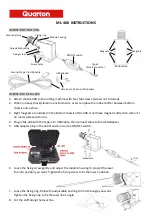
AMI Analyzer Manual
Analyzer Description
20
General Information
Basic knowledge about oxygen measurement
Oxygen is a chemically active gas that is present in the atmosphere at 20.9% concentration. It is essential
for animals including humans as it is the active part of air used in breathing. However since it is so active,
small amounts of it can cause havoc in situations which are not supposed to have it. In natural gas, for
example, small amounts of oxygen cause the other chemicals present in the gas to combine to form acids
that destroy piping and chemical systems; in semiconductor manufacturing it changes expensive integrated
circuits into sand, or at least stops them from working properly. In chemical operations it can prevent
polymerization or otherwise degrade the performance of the process.
Gases obey the gas laws formulated in the end of the 18
th
century and still not well understood by many
people. A gas consists of a very large number of independent molecules that fly around in otherwise empty
space. Gases don’t interact with each other (normally), so that you can treat the behavior of each gas as if
no other gases were present. Thus you can consider that air consists of nitrogen at about 11psia, and
oxygen at about 3 psia, and various other gases at lower pressures. “psia” stands for Pounds per Square
Inch Absolute, i.e. it is the pressure above zero, not the pressure above atmospheric pressure as it would be
if we were to use the units psig (Pounds per Square Inch Gauge). Since we are only worried about oxygen,
mostly because nitrogen does not matter normally to the chemistry we are worried about, we can think of
air as being pure oxygen at 3 psia pressure. In a pure gas stream, or in natural gas, there is zero oxygen
ideally, i.e. it is at zero pressure. This means that if there is a leak in the piping, there exists a pressure
difference of 3psia forcing oxygen into the leak. The oxygen doesn’t care about or see the other gas in the
pipe, it thinks of the pipe as being a vacuum. People normally don’t intuitively understand this, they think
of the gas as being rather like a pipe full of oil in the sea, where if there’s a leak oil will come out but it will
keep any water out of the pipe. However that’s not the way it is with gases because the space between the
molecules is very much larger for a gas than it is for a liquid, so one gas does not push another out of the
way.
The bottom line is that oxygen from the air will force its way into a pure gas system regardless of the
pressure in the system. It will do this through little holes, or through permeable materials such as all
plastics or rubbers, to greater or lesser extent. Nitrogen will do this as well, but since nitrogen is
comparatively inert normally its presence doesn’t matter. Also it is much harder to measure, while oxygen
is comparatively easy, hence oxygen is normally used to verify the integrity of the system.
As a consequence of this, the integrity of the oxygen analyzer sample system is critical. AMI analyzers are
designed around a patented “Cell block” that integrates all of the sample handling elements into one solid
chunk of metal, resulting in much fewer leak sources and therefore much greater reliability, as well as lower
cost.
It is just as important that the analyzer’s sample system – the components used to control the gas flow –
are perfect as the measurement methodology itself. No matter how good the analyzer is, if you don’t
connect the plumbing correctly you won’t get good results.
















































